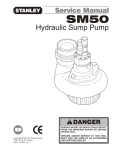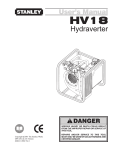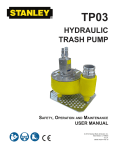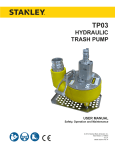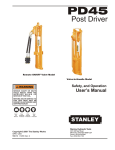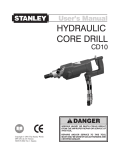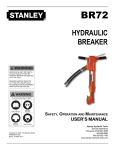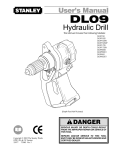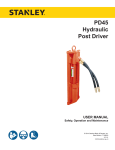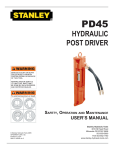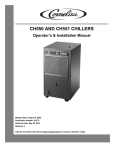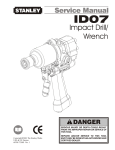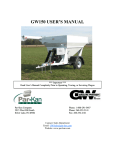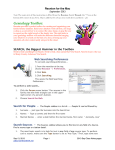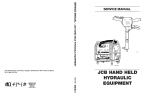Download HYDRAULIC TRASH PUMP
Transcript
User’s Manual TP03 HYDRAULIC TRASH PUMP MODEL: TP0300301, TP0300303 DANGER SERIOUS INJURY OR DEATH COULD RESULT FROM THE IMPROPER REPAIR OR SERVICE OF THIS TOOL. Copyright c 2001 The Stanley Works OPS USA & CE Version 58555 7/2002 Ver. 2 REPAIRS AND/OR SERVICE TO THIS TOOL MUST ONLY BE DONE BY AN AUTHORIZED AND CERTIFIED DEALER. Table of Contents TP03 Hydraulic Trash Pump SERVICING THE TP03 Hydraulic Trash Pump This manual contains Safety, Operation, and Troubleshooting information. Stanley Hydraulic Tools recommends that servicing of hydraulic tools, other than routine maintenance, must be performed by an authorized and certified dealer. Please read the DANGER warning on the cover and the Copyright c 2001 The Stanley Works All rights reserved. Under copyright law, this document may not be copied in whole or in part without the prior written consent of The Stanley Works. This exception does not permit copies to be made for others, whether or not sold. Under the law, copying includes translating into another language, format or medium. This copyright notice must appear on any permitted copies. 2 Certificate of Conformity 3 Specifications 3 General Safety Instructions 4 Tools Decals and Tags 5 Hydraulic Hose Requirements 6 HTMA Requirements 7 Operating Instructions 8 Troubleshooting 10 Parts Illustration 11 Parts List 12 Accessories 12 Warranty 13 SAFETY FIRST It is the responsibility of the operator and service technician to read rules and instructions for safe and proper operation and maintenance. A cautious worker using common sense is the greatest safety device. Certificate of Conformity I, the undersigned: Mellits, Kirk E. Surname and First Names hereby certify that the construction plant or equipment specified hereunder: 1. Category: Trash Pump (Hydraulic) 2. Make: Stanley 3. Type: TP0300301, TP0300303 4. Type Serial Number of equipment: 5. Year of manufacture: 2001 ALL has been manufactured in conformity with- EEC Type examination as shown: Directive: EN 809 Approved body: Self Date of expiration: N/A EN ISO 3744 Date: 2001 6. Special Provisions: Done at: None Stanley Hydraulic Tools, Milwaukie, Oregon USA Date: 2001 Position: Engineering Manager Signature: Specifications Pressure Range________1500-2000 psi / 140 bar Maximum Back Pressure________ 250 psi / 17 bar Couplers_________________ HTMA Flush Face Per NFPA T3.20.15/ISO 16028 Connect Size & Type___ 1/2 in. Male Pipe Adapter Weight_______ 31lbs./14kg(Urethane Case) Overall Length________________ 14 in./ 35.5 cm Overall Width__________________ 16 in./ 41 cm Overall Height _______________16.5 in. / 41.9 cm Max. Fluid Temp._____________ 140° F / 60° C Capacity_________________450 gpm / 1688 lpm Flow Range______________7-9 gpm / 26-34 lpm Maximum Flow________________9 gpm / 34 lpm System Type_____________O.C, HTMA Type 2 Porting________________________1/2 in. NPTF Liquid Outlet Size______________Urethane Case, 3 inch Female Pipe HTMA Class II___________7-9 gpm @ 2000 psi 30Lpm at 138bar BHTMA CATEGORY EHTMA Category_____30 lpm @ 138 bar Sound Pressure______________ <85 dBA @ 1m Vibration Level________________________N/A 3 General Safety Instructions Always observe safety symbols. They are included for your safety and the protection of the tool. WARNING DANGER This safety symbol may appear on the tool. It is used to alert the operator of an action that could place him/her or others in a life threatening situation. This safety symbol appears in these instructions to identify an action that could cause bodily injury to the operator or other personnel. CAUTION This safety symbol appears in these instructions to identify an action or condition that could result in damage to the tool or other equipment. This tool will provide safe and dependable service if operated in accordance with the instructions given in this manual. Read and understand this manual and any stickers and tags attached to the tool and hoses before operation. Failure to do so could result in personal injury or equipment damage. A Operator must start in a work area without bystanders. The operator must be familiar with all prohibited work areas such as excessive slopes and dangerous terrain conditions. A Establish a training program for all operators to ensure safe operations. A Do not operate the tool unless thoroughly trained or under the supervision of an instructor. A Always wear safety equipment such as goggles, head protection, and safety shoes at all times when operating the tool. A Do not inspect or clean the tool while the hydraulic power source is connected. Accidental engagement of the tool can cause serious injury. A Do not operate this tool without first reading the Operating Instructions. A Do not install or remove this tool while the hydraulic power source is connected. Accidental engagement of the tool can cause serious injury. A Never operate the tool if you cannot be sure that underground utilities are not present. Underground electrical utilities present an electrocution hazard. Underground gas utilities present an explosion hazard. Other underground utilities may present other hazards. A Do not wear loose fitting clothing when operating the tool. Loose fitting clothing can get entangled with the tool and cause serious injury. A Supply hoses must have a minimum working pressure rating of 2500 psi/175 bar. A Be sure all hose connections are tight. A The hydraulic circuit control valve must be in the “OFF” position when coupling or uncoupling the tool. Wipe all couplers clean before connecting. Failure to do so may result in damage to the quick couplers and cause overheating. Use only lint-free cloths. A Do not operate the tool at oil temperatures above 140° F/60° C. Operation at higher oil temperatures can cause operator discomfort and may cause damage to the tool. A Do not operate a damaged, improperly adjusted, or incompletely assembled tool. A To avoid personal injury or equipment damage, all tool repair, maintenance and service must only be performed by authorized and properly trained personnel. A Do not exceed the rated limits of the tool or use the tool for applications beyond its design capacity. A Always keep critical tool markings, such as labels and warning stickers legible. A Always replace parts with replacement parts recommended by Stanley Hydraulic Tools. A Check fastener tightness often and before each use daily. 4 Tool Decals & Tags A Name Tag Sticker is attached to the tool. Never exceed the flow and pressure levels specified on this sticker. The information listed on the name tag sticker must be legible at all times. Replace this sticker if it becomes worn or damaged. A replacement is available from your local Stanley distributor. 28786 Coupler Sticker 30Lpm at 138bar BHTMA CATEGORY 11207 Circuit Type “D” Decal 28788 Manual Sticker Stanley Sticker 05152 CAUTION 7-9 GPM/ 26-34 LPM DO NOT EXCEED 2000 PSI/ 140 BAR n DO NOT EXCEED SPECIFIED FLOW OR PRESSURE. n USE CLOSED-CENTER TOOL ON CLOSED-CENTER SYSTEM. n USE OPEN-CENTER TOOL ON OPEN-CENTER SYSTEM. n CORRECTLY CONNECT HOSES TO TOOL "IN" AND "OUT" PORTS. n IMPROPER HANDLING, USE OR MAINTENANCE OF TOOL COULD RESULT IN A LEAK, BURST OR OTHER TOOL FAILURE. n CONTACT AT A LEAK OR BURST CAN CAUSE OIL INJECTION INTO THE BODY. n FAILURE TO OBSERVE THESE PRECAUTIONS CAN RESULT IN SERIOUS PERSONAL INJURY. 03796 Model and Serial Number Information 03786 Caution Sticker 28322 “CE” Decal DANGER DANGER 1. FAILURE TO USE HYDRAULIC HOSE LABELED AND CERTI-FIED AS NON-CONDUCTIVE WHEN USING HYDRAULIC TOOLS ON OR NEAR ELECTRICAL LINES MAY RESULT IN DEATH OR SERIOUS INJURY. BEFORE USING HOSE LABELED AND CERTIFIED AS NON- CONDUCTIVE ON OR NEAR ELECTRIC LINES. BE SURE THE HOSE IS MAINTAINED AS NON- CONDUC TIVE . THE HOSE SHOULD BE REGULARLY TESTED FOR ELECTRIC CURRENT LEAKAGE IN ACCORDANCE WITH YOUR SAFETY DEPARTMENT INSTRUCTIONS. 2. A HYDRAULIC LEAK OR BURST MAY CAUSE OIL INJECTION INTO THE BODY OR CAUSE OTHER SEVERE PERSONAL INJURY. A.DO NOT EXCEED SPECIFIED FLOW AND PRESSURE FOR THIS TOOL. EXCESS FLOW OR PRESSURE MAY CAUSE A LEAK OR BURST. B. DO NOT EXCEED RATED WORKING PRESSURE OF HYDRAULIC HOSE USED WITH THIS TOOL. EXCESS PRESSURE MAY CAUSE A LEAK OR BURST. C. C H E C K T O O L , H O S E , C O U P L E R S & C O N N E C T O R S D A I L Y F O R LEAKS. DO NOT FEEL FOR LEAKS WITH YOUR HANDS. CONTACT WITH A LEAK MAY RESULT IN SEVERE PERSONAL INJURY. The SAFETY TAG, P/N 15875, shown at right, smaller than actual size, is attached to the tool when shipped from the factory. Read and understand the safety instructions listed on this tag before removal. We suggest you retain this tag and attach it to the tool when not in use. D. DO NOT LIFT OR CARRY TOOL BY THE HOSES. DO NOT ABUSE HOSE. DO NOT USE KINKED, TORN OR DAMAGED HOSES. 3. MAKE SURE HYDRAULIC HOSES ARE PROPERLY CONN-ECTED TO THE TOOL BEFORE PRESSURIZING SYSTEM. SYSTEM PRESSURE HOSE MUST ALWAYS BE CONNECTED TO TOOL “IN” PORT. SYSTEM RETURN HOSE MUST ALWAYS BE CONNECTED AT TOOL “OUT” PORT. REVERSING CONNECTIONS MAY CAUSE REVERSE TOOL OPERATION WHICH CAN CAUSE SEVERE PERSONAL INJURY. 4. DO NOT CONNECT CLOSED-CENTER TOOLS TO OPEN-CENTER HYDRAULIC SYSTEMS. THIS MAY CAUSE EXTREME SYSTEM HEAT AND/OR SEVERE PERSONAL INJURY. DO NOT CONNECT OPEN-CENTER TOOLS TO CLO SE D- CE NT ER HYDRAULIC SYSTEMS. THIS MAY RESULT IN LOSS OF OTHER HYDRAULIC FUNCTIONS POWERED BY THE SAME SYSTEM AND/OR SEVERE PERSONAL INJURY. 5. BYSTANDERS MAY BE INJURED IN YOUR WORK AREA. KEEP BYSTANDERS CLEAR OF YOUR WORK AREA. 6. WEAR HEARING, EYE, FOOT, HAND AND HEAD PROTECTION. 7. TO AVOID PERSONAL INJURY OR EQUIPMENT DAMAGE, ALL TOOL REPAIR, MAINTENANCE AND SERVICE MUST BE PERFORMED BY AUTHORIZED AN D PR OP ER LY TRAINED PERSONNEL. IMPORTANT IMPORTANT READ OPERATION MANUAL AND SAFETY INSTRUCTIONS FOR THIS TOOL BEFORE USING IT. READ OPERATION MANUAL AND SAFETY INSTRUCTIONS FOR THIS TOOL BEFORE USING IT. USE ONLY PARTS AND REPAIR PROCEDURES APPROVED BY STANLEY AND DESCRIBED IN THE OPERATION MANUAL. USE ONLY PARTS AND REPAIR PROCEDURES APPROVED BY STANLEY AND DESCRIBED IN THE OPERATION MANUAL. TAG TO BE REMOVED ONLY BY TOOL OPERATOR. (517) SEE OTHER SIDE 15875 TAG TO BE REMOVED ONLY BY TOOL OPERATOR. (517) SEE OTHER SIDE 15875 5 Hydraulic Hose Requirements HOSE TYPES Hydraulic hose types authorized for use with Stanley Hydraulic Tools are as follows: Certified non-conductive Wire-braided (conductive) Fabric-braided (not certified or labeled non-conductive) Hose listed above is the only hose authorized for use near electrical conductors. Hoses and listed above are conductive and must never be near electrical conductors. HOSE SAFETY TAGS To help ensure your safety, the following DANGER tags are attached to all hoses purchased from Stanley Hydraulic Tools. DO NOT REMOVE THESE TAGS. If the information in a tag is illegible because of wear or damage, replace the tag immediately. A new tag may be obtained at no charge from your Stanley Distributor. This Tag attached to “Certified Non-Conductive” hose. DANGER 1. FAILURE TO USE HYDRAULIC HOSE LABELED AND CERTIFIED AS NON-CONDUCTIVE WHEN USING HYDRAULIC TOOLS ON OR NEAR ELECTRIC LINES MAY RESULT IN DEATH OR SERIOUS INJURY. FOR PROPER AND SAFE OPERATION, MAKE SURE THAT YOU HAVE BEEN PROPERLY TRAINED IN CORRECT PROCEDURES REQUIRED FOR WORK ON OR AROUND ELECTRIC LINES. 2. BEFORE USING HYDRAULIC HOSE LABELED AND CERTIFIED AS NON-CONDUCTIVE ON OR NEAR ELECTRIC LINES, WIPE THE ENTIRE LENGTH OF THE HOSE AND FITTINGS WITH A CLEAN, DRY, ABSORBENT CLOTH TO REMOVE DIRT AND MOISTURE AND TEST HOSE FOR MAXIMUM ALLOWABLE CURRENT LEAKAGE IN ACCORDANCE WITH SAFETY DEPARTMENT INSTRUCTIONS. DANGER 4. HANDLE AND ROUTE HOSE CAREFULLY TO AVOID KINKING, ABRASION, CUTTING OR CONTACT WITH HIGH TEMPERATURE SURFACES. DO NOT USE IF KINKED. DO NOT USE HOSE TO PULL OR LIFT TOOLS, POWER UNITS, ETC. 5. CHECK ENTIRE HOSE FOR CUTS, CRACKS, LEAKS, ABRASIONS, BULGES OR DAMAGE TO COUPLINGS. IF ANY OF THESE CONDITIONS EXIST, REPLACE THE HOSE IMMEDIATELY. NEVER USE TAPE OR ANY DEVICE TO ATTEMPT TO MEND THE HOSE. 6. AFTER EACH USE, STORE IN A CLEAN, DRY AREA. 3. DO NOT EXCEED HOSE WORKING PRESSURE OR ABUSE HOSE. IMPROPER USE OR HANDLING OF HOSE COULD RESULT IN BURST OR OTHER HOSE FAILURE. KEEP HOSE AS FAR AWAY AS POSSIBLE FROM BODY AND DO NOT PERMIT DIRECT CONTACT DURING USE. CONTACT AT THE BURST CAN CAUSE BODILY INJECTION AND SEVERE PERSONAL INJURY. SEE OTHER SIDE SEE OTHER SIDE Side 1 Side 2 DO NOT REMOVE THIS TAG DO NOT REMOVE THIS TAG (shown smaller than actual size) p/n 27987 This Tag attached to “Conductive” hose. DANGER DANGER 1. DO NOT USE THIS HYDRAULIC HOSE ON OR NEAR ELECTRIC LINES. THIS HOSE IS NOT LABELED OR CERTIFIED AS NON-CONDUCTIVE. USING THIS HOSE ON OR NEAR ELECTRIC LINES MAY RESULT IN DEATH OR SERIOUS INJURY. 5. CHECK ENTIRE HOSE FOR CUTS, CRACKS, LEAKS, ABRASIONS, BULGES OR DAMAGE TO COUPLINGS. IF ANY OF THESE CONDITIONS EXIST, REPLACE THE HOSE IMMEDIATELY. NEVER USE TAPE OR ANY DEVICE TO ATTEMPT TO MEND THE HOSE. 2. FOR PROPER AND SAFE OPERATION, MAKE SURE THAT YOU HAVE BEEN PROPERLY TRAINED IN CORRECT PROCEDURES REQUIRED FOR WORK ON OR AROUND ELECTRIC LINES. 6. AFTER EACH USE, STORE IN A CLEAN, DRY AREA. 3. DO NOT EXCEED HOSE WORKING PRESSURE OR ABUSE HOSE. IMPROPER USE OR HANDLING OF HOSE COULD RESULT IN BURST OR OTHER HOSE FAILURE. KEEP HOSE AS FAR AWAY AS POSSIBLE FROM BODY AND DO NOT PERMIT CONTACT DURING USE. CONTACT AT THE BURST CAN CAUSE BODILY INJECTION AND SEVERE PERSONAL INJURY. 4. HANDLE AND ROUTE HOSE CAREFULLY TO AVOID KINKING, ABRASION, CUTTING OR CONTACT WITH HIGH TEMPERATURE SURFACES. DO NOT USE IF KINKED. DO NOT USE HOSE TO PULL OR LIFT TOOLS, POWER UNITS, ETC. SEE OTHER SIDE SEE OTHER SIDE Side 1 Side 2 DO NOT REMOVE THIS TAG DO NOT REMOVE THIS TAG (shown smaller than actual size) p/n 29144 HOSE PRESSURE RATING The rated working pressure of the hydraulic hose must be equal to or higher than the relief valve setting on the hydraulic system. 6 HTMA Requirements NOTE: These are general hydraulic system requirements. See tool specification page for tool specific requirements. Hydraulic System Requirements Tool Category: C 20Lpm at 138bar BHTMA CATEGORY Type I 30Lpm at 138bar BHTMA CATEGORY Type II Type III 4-6 GPM (15-23 lpm) 2000 psi (138 bar) 7-9 GPM (26-34 lpm) 2000 psi (138 bar) 11-13 GPM (42-49 lpm) 2000 psi (138 bar) 2100-2250 2100-2250 2100-2250 (145-155 bar) (145-155 bar) (145-155 bar) 250 psi 250 psi 250 psi (17 bar) (17 bar) (17 bar) (at min. operating temperature) 400 SSU 400 SSU 400 SSU (82 centistokes) (82 centistokes) (82 centistokes) Temperature Sufficient heat rejection capacity to limit max. fluid temperature to: 140° F (60° C) 140° F (60° C) 140° F (60° C) 3 hp (2.24 kW) 40° F (22° C) 5 hp (3.73 kW) 40° F (22° C) 7 hp (5.22 kW) 40° F (22° C) Flow rate Tool Operating Pressure (at the power supply outlet) System relief valve setting (at the power supply outlet) Maximum back pressure (at tool end of the return hose) Measured at a max. fluid viscosity of: (at max. expected ambient temperature) Min. cooling capacity at a temperature difference of between ambient and fluid temps NOTE: Do not operate the tool at oil temperatures above 140° F (60° C). Operation at higher temperatures can cause operator discomfort at the tool. Filter Min. full-flow filtration sized for flow of at least: 25 microns 30 GPM (114 lpm) 25 microns 30 GPM (114 lpm) 25 microns 30 GPM (114 lpm) (For cold temp. startup and max. dirt-holding capacity) Hydraulic fluid Petroleum based (premium grade, anti-wear, non-conductive) Viscosity (at min. and max. operating temps) 100-400 SSU* 100-400 SSU* 100-400 SSU* (20-82 centistokes) (20-82 centistokes) (20-82 centistokes) NOTE: When choosing hydraulic fluid, the expected oil temperature extremes that will be experienced in service determine the most suitable temperature viscosity characteristics. Hydraulic fluids with a viscosity index over 140 will meet the requirements over a wide range of operating temperatures. *SSU = Saybolt Seconds Universal NOTE: These are general hydraulic system requirements. See tool Specification page for tool specific requirements. 7 Operating Instructions Pre-operation Procedures Pump Operation Check The Power Source 1. Observe all safety precautions. 1. Using the calibrated flowmeter and pressure gauge, check that the hydraulic power source develops a flow of 7-9 gpm/26-34 lpm at 1500-2000 ps/105-140 bar. 2. Attach a 3-inch/76 mm diameter discharge hose to the pump outlet. For the best performance, keep the discharge hose as short as possible and lay it out to avoid sharp bends or kinks. 2. Make certain the hydraulic power source is equipped with a relief valve set to crack at 2150-2250 psi/150-155 bar maximum. 3. Check that the pump inlet is clear of debris. Remove any obstructions before operating the pump. Refer to CLEANING THE PUMPING CHAMBER. Connect Hoses 1. Wipe all hose couplers with a clean lint-free cloth before making connections. Do not attach a nozzle to the outlet of the discharge hose. For high-pressure water pumping, use a Stanley SM20 and nozzle. The TP03 is designed for high gpm water flow at low pressure. 3. Attach a rope or cable to the lifting eye at the top of the pump. Lower the pump into the liquid to be pumped. Do not raise or lower the pump by its hoses or couplers to avoid damage to the hoses or couplers. WARNING Never point the hose at bystanders. CAUTION Do not connect pressure to the return port. Motor shaft seal limit is 250 psi/17 bar. 2. Connect the hoses from the hydraulic power source to the couplers on the pump or pump hoses. It is a good practice to connect return hoses first and disconnect them last to minimize or avoid trapped pressure in the pump motor. NOTE: If uncoupled hoses are left in the sun, heat may cause a pressure increase inside the hoses making them difficult to connect. When possible, connect the free ends of the operating hoses together. 3. If hose couplers are used, observe the arrow on the coupler to ensure that the flow is in the proper direction. The female coupler on the pump is the inlet coupler. 8 4. Turn on the hydraulic power source. NOTE: It will not damage the pump to run it “DRY” 5. When pumping is completed, set the hydraulic on/off valve at the hydraulic power source to OFF. Lift the pump from the liquid using the rope or cable. CAUTION Perform steps 6 thru 8 for pump protection and care. 6. The pump must maintain a minimum RPM and water speed to move solid particles through the pump (high speed water is required to push solids through the large pump). When pumping liquids containing large solids, monitor the flow from the outlet of the discharge hose. If it begins to slow turn off the hydraulic power source and raise the pump. Disconnect the hydraulic hoses. See CLEANING THE PUMPING CHAMBER. Operating Instructions CAUTION Pumping liquids with a solids-to-liquid ratio greater than 30% solids to 70% liquid will accelerate impeller wear. 7. To maintain performance it is good practice to periodically inspect the impeller for wear or damage. This is especially important following the pumping of liquids containing sharp, abrasive solids. 8. Turn off the hydraulic power source before raising the pump. Raise the pump by the rope or cable attached to its top to avoid damaging the hoses and couplings. Cold Weather Operation If the pump is to be used during cold weather, preheat the hydraulic fluid at low engine speed. When using the normally recommended fluids, fluid should be at or above 50°F/10°C (400 ssu/ 82 centistrokes) before use. Damage to the hydraulic system or pump motor could result from using fluid that is too viscous or thick. Cleaning The Pumping Chamber 2. Clear the debris and determine whether or not the discharge hose is clogged or the power source is not providing adequate flow/pressure to properly drive the pump. If the pump is not cleared, heavy solids will not be removed from the pump, eventually damaging or destroying the impeller. 3. Place the motor adapter plate over the case studs. 4. Install the handle and lifting eye on the motor adapter plate and secure with six 3/8-16 wing nuts. Tighten by hand only. 5. Install the hoses and couplers. NOTE: A slot has been milled in the underside of the aluminum motor adapter plate near the pump outlet. This slot allows air near the impeller to be submerged and prevents binding. Inspect this slot before each use to ensure that no obstruction blocks this vent slot. It is normal for a small amount of water to squirt from this slot while pumping. 1. Remove the six 3/8-16 wing nuts securing the motor adapter plate and motor to the case. 9 Troubleshooting This section describes how to find and resolve problems users may experience. If a situation occurs that is not covered, call your Stanley Customer Service representative for assistance. WARNING Inspecting the tool or installing parts with the hydraulic hoses connected can result in severe personal injury or equipment damage. To prevent accidental startup, disconnect the hydraulic power before beginning any inspection or installation task. If symptoms of poor performance develop, the following chart can be used as a guide to correct the problem. When diagnosing faults in operation of the tool, always check that the hydraulic power source is supplying the correct hydraulic flow and pressure to the tool as listed in the table. Use a flowmeter known to be accurate. Check the flow with the hydraulic oil temperature at least 80° F/27° C. Symptom Tool will not start. Possible Cause No hydraulic flow or pressure. Turn on power source and check that 7-9 gpm / 26-34 lpm at 1500-2000 psi / 101-140 bar is available at the pump. Defective couplers. Check the couplers by connecting them together with the hydraulic power source operating and the control valve “ON”. The power supply should operate without “loading” from plugged couplers. Impeller jammed with debris. Clean the pumping chamber as described in the OPERATING INSTRUCTIONS section of this manual. Contact Authorized Distributor. Motor failure. Poor tool performance. Hydraulic oil in discharge flow. 10 Solution Incorrect hydraulic flow or pressure. Turn “ON” power source, check that 7-9 gpm/ 26-34 lpm at 1500-2000 psi/ 101-149 bar is available at the pump. Inlet to pump may be blocked. Inspect and clear. If pump settled into sediment, suspend pump above sediment or place flat, solid surface under the pump. Discharge hose restricted. Straighten hose and remove kinks. Impeller worn excessively. Contact Authorized Distributor. Motor shaft seal failure. Contact Authorized Distributor. TP03 Parts Illustration 2 1 3 29 4 3 28 20 27 5 26 19 6 25 8 7 24 1 16 18 17 9 15 21 10 14 21 23 MODEL/SN INFO 11 12 22 22 12 13 11 TP03 Parts List NOTE: Earlier models of the TP03 used a “DOWTY or HEMA” motor. If you are currently using a earlier TP03 with either of these motors installed, see your Authorized Distributor to obtain a correct manual (Manual P/N-07218). NOTE: Use Part Number and Description when ordering. Item 1 2 3 4 5 6 7 8 9 10 11 12 13 14 15 16 17 18 19 20 21 22 23 24 25 26 27 28 29 Part No . Description QTY 07210 07208 371503 07207 24061 06264 24381 04353 03786 28322 07202 21978 07200 05152 28786 11207 28788 00635 39426 24060 38702 38701 07206 07209 21917 51301 09661 01324 22294 07201 Wing Nut, 3/ 8-16- TP03 Eye Bolt, 3/8-16- TP03 Nut 3/8-16 UNC PLT Handle- TP03 Male Coupler Adaptor Fit. -12/1/2 NPT TP03 Motor Cassapa Nut, 3/8-16 ESNA GPM Sticker Sticker “CE” 25 mm Motor Adapter Plate Capscrew 3/8-16 x 1.75 Impeller-TP03 Stanley Sticker Coupler Sticker Circuit Type D Sticker Manual Sticker Key, Motor Shaft, 3/16 x 3/4 Adaptor -14 SAE / 1/2NPT Female Coupler Jam Nut, 1/ 2-13 Zinc Screw, Slot FHMS Pump Support- TP03 Stud, 3/8-16 x 2- TP03 Urethane Bowl TP0300303 (Venezuelan Army Only) Capscrew- TP04 Lockwasher Washer Rubber Gasket- Tp03 6 1 2 1 1 1 1 2 1 1 1 2 1 1 1 1 1 1 1 1 3 3 1 6 1 1 1 1 1 26230 Seal Kit 1 Accessories NOTE: Use Part Number and Description when ordering. 12 Part Description 56761 3 inch x 25 ft Lay-Flat Cam-Lock Hose 52720 3 inch Male Pipe x 3 in Male Cam-Lock Fitting Warranty Stanley Hydraulic Tools (hereinafter called “Stanley”), subject to the exceptions contained below, warrants new hydraulic tools for a period of one year from the date of sale to the first retail purchaser, or for a period of 2 years from the shipping date from Stanley, whichever period expires first, to be free of defects in material and/or workmanship at the time of delivery, and will, at its option, repair or replace any tool or part of a tool, or new part, which is found upon examination by a Stanley authorized service outlet or by Stanley’s factory in Milwaukie, Oregon to be DEFECTIVE IN MATERIAL AND/OR WORKMANSHIP. EXCEPTIONS FROM WARRANTY NEW PARTS: New parts which are obtained individually are warranted, subject to the exceptions herein, to be free of defects in material and/or workmanship at the time of delivery and for a period of 6 months after the date of first usage. Seals and diaphragms are warranted to be free of defects in material and/or workmanship at the time of delivery and for a period of 6 months after the date of first usage or 2 years after the date of delivery, whichever period expires first. Warranty for new parts is limited to replacement of defective parts only. Labor is not covered. FREIGHT COSTS: Freight costs to return parts to Stanley, if requested by Stanley for the purpose of evaluating a warranty claim for warranty credit, are covered under this policy if the claimed part or parts are approved for warranty credit. Freight costs for any part or parts which are not approved for warranty credit will be the responsibility of the individual. SEALS & DIAPHRAGMS: Seals and diaphragms installed in new tools are warranted to be free of defects in material and/or workmanship for a period of 6 months after the date of first usage, or for a period of 2 years from the shipping date from Stanley, whichever period expires first. CUTTING ACCESSORIES: Cutting accessories such as breaker tool bits are warranted to be free of defects in material and or workmanship at the time of delivery only. ITEMS PRODUCED BY OTHER MANUFACTURERS: Components which are not manufactured by Stanley and are warranted by their respective manufacturers. a. Costs incurred to remove a Stanley manufactured component in order to service an item manufactured by other manufacturers. ALTERATIONS & MODIFICATIONS: Alterations or modifications to any tool or part. All obligations under this warranty shall be terminated if the new tool or part is altered or modified in any way. NORMAL WEAR: Any failure or performance deficiency attributable to normal wear and tear such as tool bushings, retaining pins, wear plates, bumpers, retaining rings and plugs, rubber bushings, recoil springs, etc. INCIDENTAL/CONSEQUENTIAL DAMAGES: To the fullest extent permitted by applicable law, in no event will STANLEY be liable for any incidental, consequential or special damages and/or expenses. FREIGHT DAMAGE: Damage caused by improper storage or freight handling. LOSS TIME: Loss of operating time to the user while the tool(s) is out of service. IMPROPER OPERATION: Any failure or performance deficiency attributable to a failure to follow the guidelines and/or procedures as outlined in the tool’s operation and maintenance manual. MAINTENANCE: Any failure or performance deficiency attributable to not maintaining the tool(s) in good operating condition as outlined in the Operation and Maintenance Manual. HYDRAULIC PRESSURE & FLOW, HEAT, TYPE OF FLUID: Any failure or performance deficiency attributable to excess hydraulic pressure, excess hydraulic back-pressure, excess hydraulic flow, excessive heat, or incorrect hydraulic fluid. REPAIRS OR ALTERATIONS: Any failure or performance deficiency attributable to repairs by anyone which in Stanley’s sole judgement caused or contributed to the failure or deficiency. MIS-APPLICATION: Any failure or performance deficiency attributable to mis-application. “Mis-application” is defined as usage of products for which they were not originally intended or usage of products in such a matter which exposes them to abuse or accident, without first obtaining the written consent of Stanley. PERMISSION TO APPLY ANY PRODUCT FOR WHICH IT WAS NOT ORIGINALLY INTENDED CAN ONLY BE OBTAINED FROM STANLEY ENGINEERING. WARRANTY REGISTRATION: STANLEY ASSUMES NO LIABILITY FOR WARRANTY CLAIMS SUBMITTED FOR WHICH NO TOOL REGISTRATION IS ON RECORD. In the event a warranty claim is submitted and no tool registration is on record, no warranty credit will be issued without first receiving documentation which proves the sale of the tool or the tools’ first date of usage. The term “DOCUMENTATION” as used in this paragraph is defined as a bill of sale, or letter of intent from the first retail customer. A WARRANTY REGISTRATION FORM THAT IS NOT ALSO ON RECORD WITH STANLEY WILL NOT BE ACCEPTED AS “DOCUMENTATION”. NO ADDITIONAL WARRANTIES OR REPRESENTATIONS This limited warranty and the obligation of Stanley thereunder is in lieu of all other warranties, expressed or implied including merchantability or 13 For additional Sales & Service information, contact: Stanley Hydraulic Tools Division of the Stanley Works 3810 SE Naef Road Milwaukie, OR 97267 USA Tel: (503) 659-5660 Fax: (503) 652-1780














